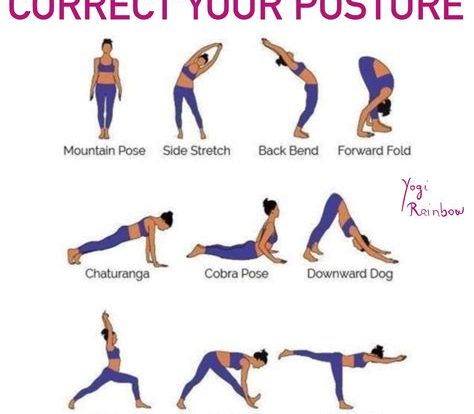
Are you a desk worker who struggles with bad posture and back pain? Long periods of desk work can wear down your body, resulting in discomfort and postural abnormalities. Yoga, fortunately, offers a remedy that can lessen these problems and encourage a happier, pain-free workplace. In this article, we’ll look at some yoga poses and stretches that were created with desk workers like you in mind. You may reduce back discomfort, enhance your general wellbeing, and improve posture by implementing these exercises into your daily routine.
1. Introduction: The Impact of Desk Work on Posture
Sitting for long amounts of time at a desk increases the risk of developing postural problems. Muscles in the back, shoulders, and neck tend to tighten up and atrophy when we sit for long periods of time. As a result of sitting for long periods of time, many people develop poor posture, including rounded shoulders, a hunched back, and spinal misalignment. In the long run, these discrepancies can cause stiffness, lack of flexibility, and pain in the lower back.
Yoga for Mindfulness: Cultivating Present-Moment Awareness
2. Understanding the Importance of Regular Movement
It is essential to incorporate regular exercise throughout the day to counteract the detrimental effects of a desk job. You can do a lot more for your health if you take brief breaks every 30 to 40 minutes. During these pauses, even a few simple yoga stretches may do wonders for your muscles, blood flow, and posture.
3. Stretching for Desk Workers: A Step-by-Step Guide
Let’s take a look at some yoga poses that will help you stay productive while you’re at work. Always pay attention to how your body feels and go at your own pace. You should cease these workouts immediately and see a doctor if you start to feel any pain or discomfort.
3.1 Sitting Opener
Start by sitting tall in your chair with your feet flat on the ground. Place your hands on your lower back, fingertips pointing downward. Inhale deeply, lift your chest upward, and gently arch your back. Hold this position for a few breaths, feeling a stretch across your chest and the front of your shoulders. Exhale and release, returning to an upright seated position.
3.2 Back Extensions
While sitting in your chair, interlace your fingers behind your head with your elbows pointing outward. Inhale deeply and lean back slightly, opening your chest and arching your upper back. Feel the stretch along your spine and breathe into it. Exhale and return to an upright position. Repeat this stretch five times.
3.3 Chin Tucks
Sit comfortably with your feet flat on the ground and your back straight. Inhale deeply and, as you exhale, gently tuck your chin toward your chest. Feel the stretch along the back of your neck. Hold for a few breaths, then release. Repeat this exercise five times.
3.4 Side Bends
Unlocking Flexibility: Yoga Poses for Increased Range of Motion
Sit up straight in your chair and place your right hand on the armrest. Inhale deeply and, as you exhale, gently lean to the left, reaching your left arm overhead. Feel the stretch along the right side of your body. Hold for a few breaths, then return to an upright position. Repeat on the other side. Perform five repetitions on each side.
4. Recommended Repetitions and Frequency
For each of the stretches mentioned above, aim to perform five repetitions. Remember to incorporate these exercises into your routine regularly. Taking short breaks every 30 to 40 minutes to stretch and move can significantly improve your posture and reduce back pain.
5. How Yoga Stretches Help Counteract the Effects of Sitting
Yoga stretches are specifically designed to target the areas affected by prolonged sitting. By engaging in these exercises regularly, you can:
- Stretch and lengthen tight muscles, reducing muscular imbalances.
- Improve spinal alignment and posture.
- Increase blood circulation, delivering vital nutrients to the muscles.
- Enhance flexibility and range of motion.
- Relieve tension and reduce the risk of chronic pain.
6. Additional Resources for Posture Correction
If you’re looking for more resources to help you correct your posture and maintain a healthy work environment, we recommend subscribing to the YogaBlogFit YouTube channel. Their videos provide valuable guidance and exercises tailored for desk workers.
7. Conclusion
In conclusion, desk work can negatively impact your posture and lead to back pain and discomfort. However, by incorporating yoga stretches into your daily routine, you can counteract these effects and improve your posture. Remember to take regular breaks, move your body, and engage in the recommended stretches we discussed. By doing so, you’ll enhance your well-being, increase productivity, and create a more comfortable work environment.
FAQs (Frequently Asked Questions)
1. How often should I perform these yoga stretches? We recommend performing these stretches every 30 to 40 minutes during your workday. Regularity is key to achieving long-term benefits.
2. Can I do these stretches if I have existing back pain? If you have existing back pain or any other medical condition, it’s essential to consult with a healthcare professional before engaging in any new exercise routine.
3. Are these stretches suitable for all fitness levels? Yes, these stretches are beginner-friendly and suitable for all fitness levels. Start slowly and gradually increase the intensity as you become more comfortable.
4. Can I perform these stretches without leaving my desk? Absolutely! These stretches are specifically designed to be performed while sitting at your desk. They are convenient and require minimal space.
5. Will yoga stretches alone solve all my posture issues? While yoga stretches can significantly improve your posture, it’s essential to incorporate other posture-conscious habits into your daily life. This includes maintaining an ergonomic workstation setup, practicing good sitting posture, and engaging in regular physical activity outside of work.

